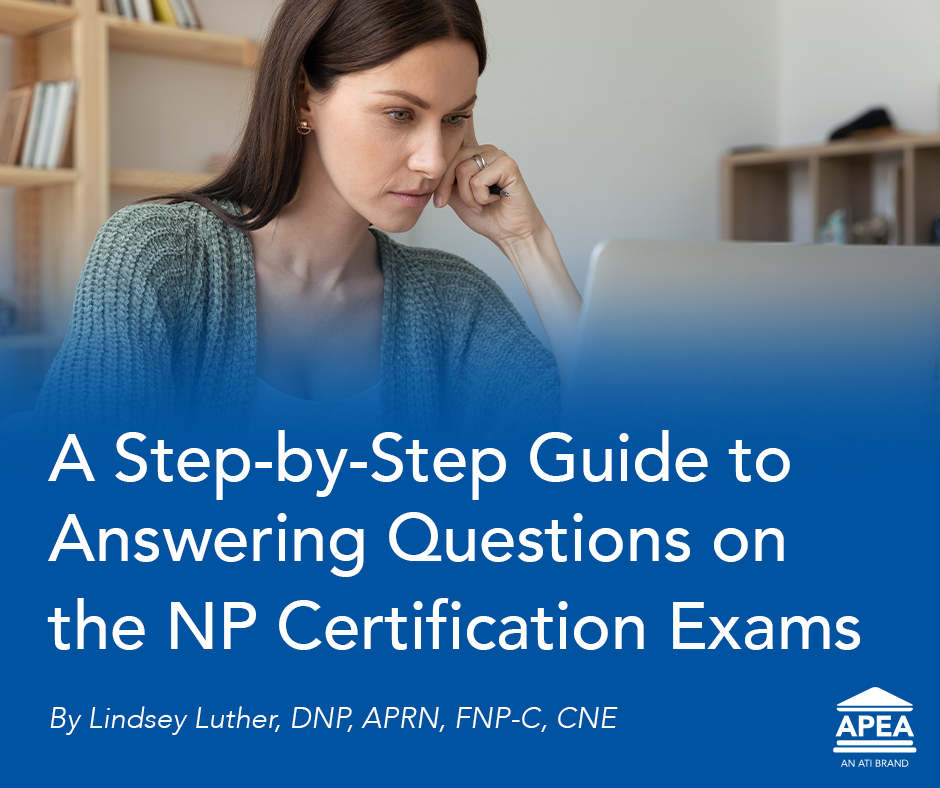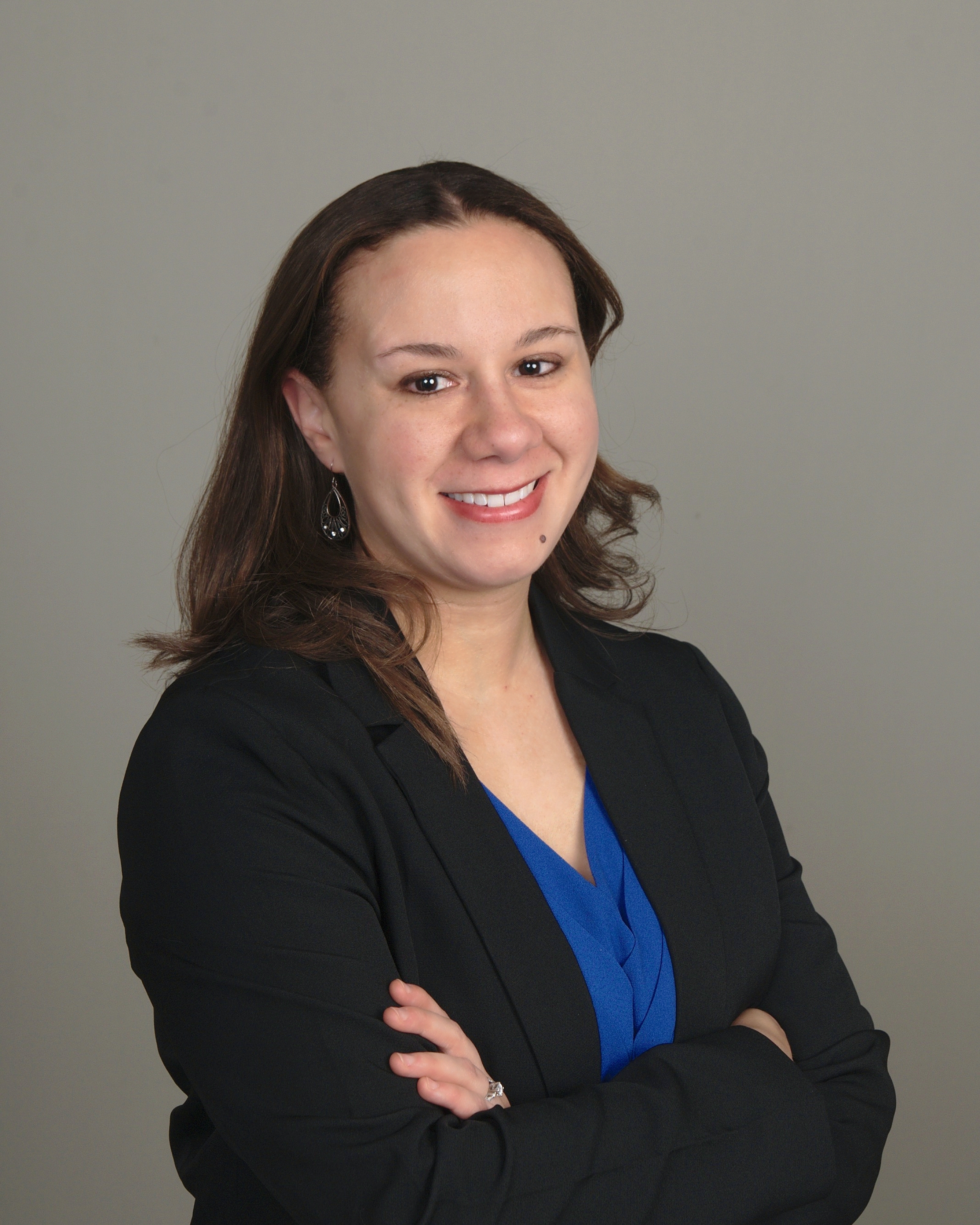A Step-by-Step Guide to Answering Questions on the NP Certification Exams
- Dec. 15, 2024
Share:

By Lindsey Luther, DNP, APRN, FNP-C, CNE
As you prepare for your nurse practitioner certification exam, it's crucial to develop a systematic approach to answering questions. When you use the method described here to answer study questions prior to your testing day, the process will become second nature and you will tackle the exam with confidence.
Let's break down this approach into actionable steps and walk through a sample question to illustrate the process.
Step 1: Read the question stem and determine what is being asked.
Begin by carefully reading the stem of the question. What is the question asking you to determine?
Step 2: Disregard irrelevant details and pay attention to descriptive words.
Filter out any information that isn't relevant to what the question is asking. Pay close attention to descriptive words such as "most," "first," "priority," and "typical." These guide you toward the correct answer. Equally as important, pay attention to negative words such as “not,” or “never,” which can significantly change the meaning of the question.
Step 3: Try to answer the question before looking at the answer choices.
Before you look at the answer choices, try to answer the question using your knowledge. This helps you focus on what you know and prevents you from being influenced by the answer options presented.
Step 4: See if your answer is among the choices.
After formulating your answer, take a look at whether it is one of the choices given. If it is, you're likely on the right track. If not, rule out the answers you know are incorrect. Don’t select an answer until you complete Step 5.
Step 5: Reread the question to validate your understanding.
Always reread the question to ensure that you've understood it correctly. This step is crucial to ensure you are answering based on the question content.
Step 6: Select the best answer or make your best guess.
Based on your rereading of the question and your knowledge, select the best answer from among the answer choices. If you're unsure, make an educated guess. If you have no idea, pick the same letter each time (e.g., always choose “A” or "C") to increase your chances of guessing correctly.
The certification exams are randomized, which means the correct answer’s “letter” is different each time the question is shown to a test taker. If you always pick the same letter when you guess, statistics show that you’ll be correct approximately 25% of the time.
Applying the Steps: A Sample Question on Pneumonia
Let's apply this question-answering system to the following sample question:
A 19-year-old female reports malaise and cough for the past 3 days. Which finding is most specific to the diagnosis of pneumonia in a patient with cough?
Step 1: Read the question stem to determine exactly what it is asking. The question is ONLY asking for the most specific finding related to a presentation of pneumonia. The key words are in this phrase: “most specific to the diagnosis of pneumonia.”
Step 2: Now you need to eliminate the information in the question that is irrelevant to arriving at the correct answer. Disregard the patient's age and gender, because they are not pertinent to the diagnosis of pneumonia. If the patient were an older adult, age might be relevant.
Step 3: Before looking at the answer choices, consider what you know about pneumonia. Divide this knowledge into two categories: specific and nonspecific. Write this information on a whiteboard or a piece of paper. (At the testing center, you will receive a whiteboard for use during your exam.)
Symptoms like shortness of breath, chest pain, malaise, and fatigue are common but not specific. They can be associated with many health conditions. Think back to your education and study and recall some signs and symptoms that are specific to pneumonia: increased tactile fremitus, egophony, and radiographic findings like infiltrates and consolidation. These should be at the forefront of your mind as possible correct answers.
Step 4: Now look for your answer among the choices. If increased tactile fremitus is an option, it stands out as a possible correct answer because it is a specific finding of pneumonia. At this point, resist the urge to select that answer. Move to Step 5.
Step 5: Reread the question to confirm that you understood its true intent. Do not select an answer before reconsidering the purpose of the question. After you review the purpose of the question, and you still think that increased tactile fremitus is correct, select it as your answer.
Step 6: If increased tactile fremitus isn't listed as an answer choice, don’t panic. Review the available options carefully and use the process of elimination to make the best possible choice. When you guess, select the same letter each time.
Additional Tips for Exam Success
In addition to the method described above, I’d like to share some general tips for approaching exam questions.
- Lean on your nursing knowledge. When a question asks you how to prioritize care, return to your NCLEX preparation (remember the ABCs — Airway, Breathing, Circulation?) and the strategies you have learned and used during your advanced nursing practice clinicals with NP preceptors.
- Follow the nursing process. Adhere to the steps of assessment, diagnosis, planning, implementation, and evaluation — always in this exact order. (These are the exact domains you’ll be evaluated on during most certification exams.)
- Apply Maslow's Hierarchy of Needs. Always address physiologic needs and safety before psychosocial concerns.
- Remember to conserve resources. When a question asks you to prioritize patient care, think with a triage mindset. Prioritize based on the resources available. Answer every question as if you were practicing in the most common setting for the patient population you were trained to manage.
- Meet acute needs first. As a nurse practitioner, you’ll need to make decisions according to the patient’s status at the time you see them. A patient with chronic obstructive pulmonary disease can usually be managed in a routine manner, but if they are experiencing an exacerbation and their breathing is deteriorating, their needs have a higher priority.
This is how you’ll walk into your certification exam with confidence
By following the 6-step question-answering method I’ve described, you will be well-equipped to succeed on the NP certification exams. Practice this approach regularly, and it will become an intuitive and powerful part of your test-taking abilities.
To support your exam prep, APEA has developed question banks for all 6 NP roles: family practice, adult-gerontology primary care, adult-gerontology acute care, psychiatric-mental health, pediatrics, and women’s health. Learn about APEA MyQBank subscriptions here.
In addition to answering practice questions, I recommend that nurse practitioner students take a live review course as part of their preparation for certification and practice. During APEA Live Review Courses, faculty members deliver comprehensive yet relatable lectures and interact one-on-one with students to answer questions and provide guidance.
Attending a live review course is an excellent investment in your career and your future. Students who attend an APEA Live Review Course often tell us that these 2 days tie together much of the information they worked to learn during their NP program. Find the calendar for live review courses here.
Share:

Lindsey Luther
Lindsey Luther is a family nurse practitioner who teaches the APEA Review Course & Clinical Update for FNPs and AGPCNPs and develops content for APEA education programs. Dr. Luther is a certified nurse educator who was an assistant professor, associate professor and FNP Team Lead at Mount Carmel College of Nursing before joining APEA. While a faculty member, Dr. Luther was awarded a grant to learn innovating teaching strategies and published multiple articles in academic journals. Her past clinical experience includes perioperative practice in outpatient and inpatient settings, and her current clinical practice is in nutrition and weight loss treatment at Central Ohio Nutrition Center. She also serves as a programming consultant to the Institute for Trauma and Psychological Safety, providing expertise on trauma-informed healthcare and educational design. Dr. Luther is a member of Sigma Theta Tau International Nursing Honor Society, the Ohio Association of Advanced Practice Nurses, and the American Association of Nurse Practitioners.